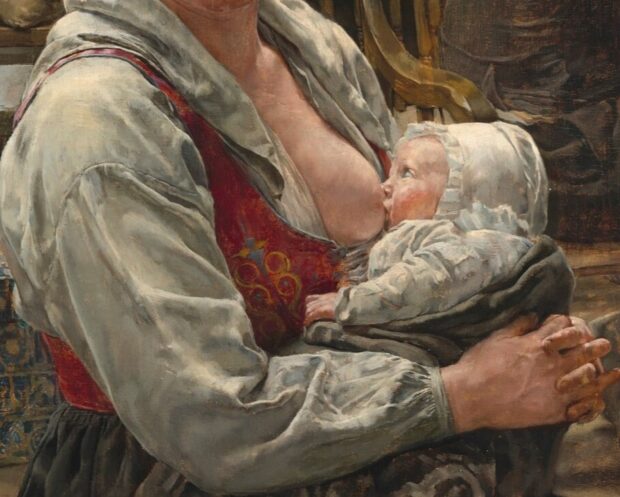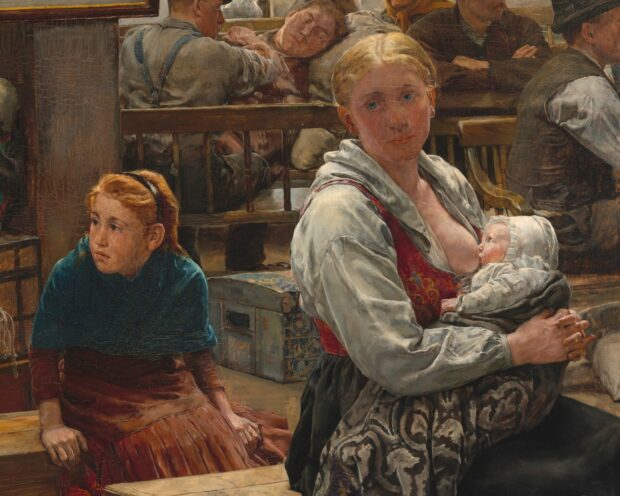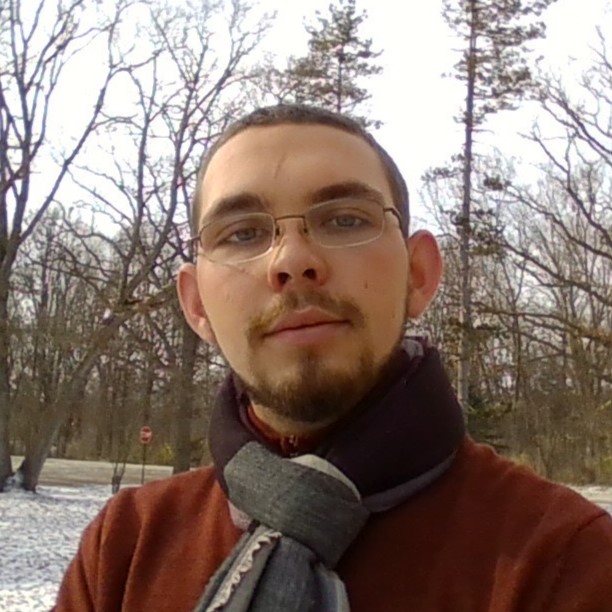|
Getting your Trinity Audio player ready...
|
During a brief sojourn in my nation’s capital to participate in the March for Life this year, a few friends and I were able to visit the National Gallery of Art. With limited time, I was intent on prioritizing works by such great painters as Sargent, Whistler, or Monet. Though I was able to examine some of their works in person and marvel at their mastery, a chance encounter with a somewhat unknown artist was what left the deepest impression on me.
Passing through the galleries, my eye was caught by Charles Frederic Ulrich’s painting “In the Land of Promise, Castle Garden,” an oil painting of moderate size—21×36 inches. Despite a distance of almost a century and a half, this painting spoke to the Pro-Life movement, to the shifting sands of familial ideologies, and to the necessity of loving the simple and domestic realities of life.
Completed in 1884, the painting is set in the clearing house location which preceded the establishment of Ellis Island—Castle Garden, located in Battery Park, at the southern end of Manhattan. The painting depicts a tired young mother nursing her child in a crowded waiting room. One might wonder if it is a beautiful commentary on self-sacrificing motherhood or an ambivalent commentary on the sorrows of immigration. Or is it a celebration of American prosperity?
Orthodox. Faithful. Free.
Sign up to get Crisis articles delivered to your inbox daily
Let us examine the composition for a moment. The faces and dress of the immigrants suggest Russian ethnicity. The color scheme of the composition is dominated by warm grays and browns. The composition uses several techniques to draw one’s eye to the nursing child: the diffuse light falling on the wall in the upper left forms a subtle spotlight on the mother, and the motion which this spotlight inspires is continued upward in the curve of the mother’s leg and foot.

On the left side, a wooden post, the curved arm of a young girl (probably the daughter of the mother), and the illuminated lid of the chest on which the mother sits bring the eye to the baby yet again. Perhaps the chest contains all of this mother’s worldly possessions. Motion toward the center is also suggested by the horizontal lines created by box and bench edges, as well as the tilted edges of the hats of the group of men in the background. Together, all of these aspects lead us to the mother.
The mother nursing is herself surprisingly anonymous. While light falls on her golden hair, linen blouse, collarbone, and breast, her face is in shadow, almost out of focus, as she looks distractedly into the distance. Another technique which orients the viewer to the focal point is the fact that the mother’s red, embroidered bodice is one of the few saturated colors in the composition. Likewise, the edges of her blouse, breast, and the baby’s bonnet are the only lines which are both hard and light in hue.

What of the other figures? Men predominate the scene. Interestingly, all of the faces of the men which are close compositionally to the girl and woman in the foreground are looking to the right. They generally seem to take no notice of the females, tired, abstracted, or busy discussing something. The women are looking one way, the men another. Only one gentleman, wearing a red and black cap and smoking a long pipe, is looking intently at the nursing mother. With such a cap, one wonders if he is a guard or official. His attention appears unwanted, as the mother seemingly avoids his gaze.
Directly behind the mother, a husband seems to be tending his sick wife—diseases were rampant among immigrants. To the left, the young girl anxiously sits on the edge of a chest, looking out of the painting. Her position is quite similar to that of the mother, and the highlights on the girl’s shoulders, covered in a blue shawl, seem to mimic or remind one of the mother’s shoulders, while both their bodies face the same general direction. The blue of the girl’s shawl is clearly echoed in the blue eyes of the mother. Was the contrast between the empty lap of the girl and the mother’s full hands intentional?
Looking at the painting from only a few inches away, the detail on the baby’s face is incredible. The brushstrokes and multitoned paint masterfully capture the warm flesh tones on the infant’s face and the mother’s breast. The round cheeks of the infant mirror the curve of the breast that it suckles. Very careful strokes on the hair, ears, and cheeks of the mother convey a soft backlighting. But mustn’t all of this technique and careful composition be in the service of an overarching meaning?
Born of immigrant parents in New York, Ulrich spent much of his life studying and working in Europe. Ulrich himself served as a commissioner on the Immigration board in the 1880’s. Many of his paintings focus on the working class and their ordinary activities, and he seemed to have taken an interest in social commentary. From one angle, this painting seems to commiserate with the sacrifices made by immigrants who come to America, the “Land of Promise,” only to often find poverty, prejudice, and decades of hard work before they or their children could benefit.
As political commentary, it could suggest that the government’s welcoming attitude toward immigrants was disproportionate to the care they could provide to such uprooted and lost souls. Given the climate of the time and the many movements to improve workers’ and immigrants’ conditions, it seems unlikely that Ulrich intended it as a representation of fertile America welcoming the foreign peoples to drink of her plenty. In fact, breastfeeding was, at the time, seen as a mark of poverty, proper to the low classes and foreigners.
Most universally, however, perhaps this painting can be seen as celebrating the endurance and self-sacrifice of mothers in such situations, while also highlighting that it is really their children who will benefit. Only the infant, content in oblivion at its mother’s breast, will ever truly experience the land of promise which she thought America might be.
Or perhaps a more supernatural undertone is appropriate. The theme certainly brings to mind scores of paintings of the Virgin nursing the Christ Child. The biblical title also makes one think of the Holy Family as exiles in Egypt; the hardships and uncertainties of parents and children were also known by the Savior as an infant, and by Mary and Joseph as a young couple.
In the end, regardless of whatever social commentary Ulrich intended the painting to have, I was glad to have seen it by chance while in town for the March for Life. Having joined thousands to pray for the protection of life, it was a memorable experience to encounter this delicate and careful portrayal of both a mother’s beauty and fertility as well as the exhaustion and self-sacrifice which she undergoes in providing and caring for her child.
As the world tries to force an ideological migration and dispossession that far surpasses any that immigrants had to undergo, this painting can be seen as a pro-life commentary on the poverty of modernity which has no Castle Garden with which to allow motherhood an entrance into our country. As a painting of fatigue, anxiety, and uncertain fortunes, it also calls its viewers to see beauty, wonder, and worth in the mundane tasks which make life possible.
As I wrote in “The Universal Call to Hobbitness,” Carol Houselander’s call to rediscover “the primitive beauty / of human things— / of love / and of birth / and of death” is more urgent today than ever before:
These “human things” of “primitive beauty” may seem so weak in the face of the global zeitgeist. But these weak things of the world have been made strong. We have, in fact, the most powerful weapons against the globalized Saurons of our own day: morning kisses, scrambled eggs, campfire songs, homegrown vegetables, and crying children are more powerful than the best laid plans of the EU or UN, the most secret schemes of Bill Gates or Cardinal Roche.
This work of art is an opportunity to meditate on the primitive beauty of human things and how our supernatural holiness will only be built upon the sanctity of the natural. Taking a moment to ponder this artwork, we can be grateful for mothers open to life. And we can remind ourselves that despite the unwelcome attention which real motherhood often receives, it will, in fact, lead us to the Land of Promise, as it has done for thousands of years.
[Image: In the Land of Promise, Castle Garden by Charles Frederic Ulrich]
